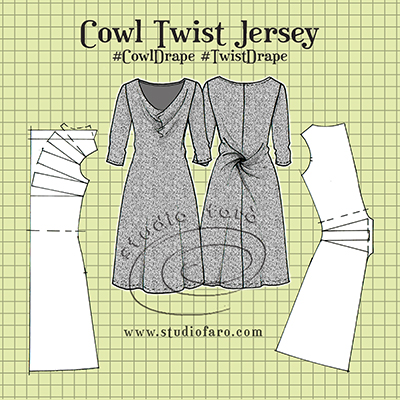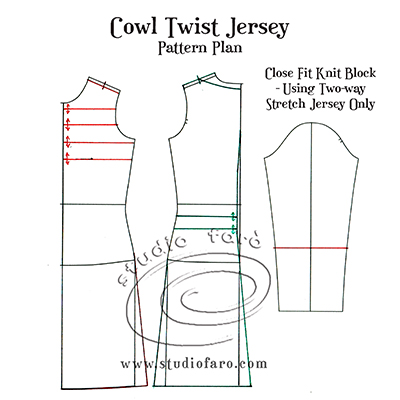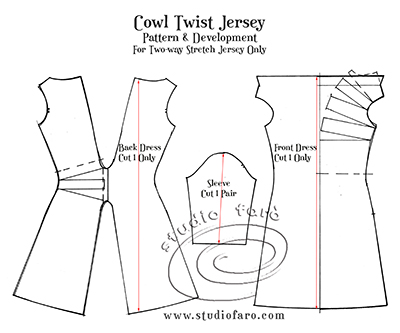22 Jun Cowl Twist Jersey
Posted at 15:35h
in Pattern Making, Pattern Making Instructions, Pattern Puzzles, Stretch Patterns, Womens Knit Block
0 Comments
About two years ago, in a Draped Dress Patterns workshop, this jersey style came into being. A combination of Cowl and Twist Drape, it proved to be a fabulous idea for students dealing with their first ever drape pattern. Using my knit block for these early drape patterns is always a plus. There is never any question about… ‘ what to do with the darts!’. If you’d like to learn my method for creating Twist Drape Patterns I have a detailed worksheet for making Jersey Twist Patterns. For just a few dollars you’ll get the same training you’d get if you came to the workshop in my studio.

This draped design will only really work if the dress is well-fitted around the body to hold the twist in shape in the back. Twists and drape often rely on the tension of a close fit to be successful. Think carefully about where you decide to place the back twist. A fan mentioned on Facebook that they were concerned the twist may be uncomfortable when sitting and leaning back. This is possible, so you may want to consider where you place the feature at the centre back. My suggestion is to also be careful about the fabric you use for this style. I think if you use a light two-way stretch merino, polyester or cotton jersey and don’t add too much fabric in the twist drape, the knot will not be uncomfortable. What the twist feature does is attract attention to the part of the body that is universally attractive – the derrière. 🙂
Trace out the front and back of your knit block and include the sleeve:
- Extend the block to your desired dress length. My diagram is for a dress length just past the knee.
- Add a small amount of flare (4-5cm), to the front and back side seam and the centre back seam, at the hemline.
- Take this opportunity to shape the centre back seam by reducing 1-1.5cm at the waist and shaping back toward the hipline and shoulder blade area.
- Mark in the cut sections on the front bodice to make drape for the front cowl neckline.
- Move the back shoulder line forward to help with the making of the wide boat neckline.
- Mark in the shoulder length, half-way along the shoulder line on the front and the back.
- On the centre back seam, at the waist level, mark in 2-3 cut lines to introduce the extra fabric for the twist drape.
- On your sleeve block mark in a three-quarter sleeve length.

To develop the drape in the front and back dress:
- Cut open the sections on the front bodice and swing them open for the Cowl Drape.
- Square (90 degrees) back from the centre front to the shoulder line for the top edge of the cowl. Mark in a 5cm turn-back facing for the front neckline.
- Cut open the sections on the back dress, at or below the waist, to introduce extra fabric for the Twist Drape.
- Add 1cm to this drape area to compensate for the loss in fabric length in the twist. Connect back to the dress with small curves for ease in sewing.

Trace out full patterns for the front and back dress. Join the back pattern at the twist area. If both sides of the back are facing in the same direction it will make a double twist. Trace your three-quarter sleeve pattern. Seam allowances of 7mm/1/4″ and hem allowances of 2cm/3/4″ will best suit the specialist seams and finishes needed for stretch sewing.

Hope you all enjoy the post. Let me know if you have any questions. I’m always happy to help. If you’d like to buy a copy of these pattern making notes for your own personal use at home you’ll find them here: Cowl Twist Jersey – Pattern Making Instructions. 🙂
Take this moment to sign up for my fabulous newsletter! Every month or so I send an email newsletter with new website content and always, always an enormous discount code for all my sewing patterns, garment blocks and pattern making instructions.
This discount code is for subscribers only. Don't miss out!


No Comments